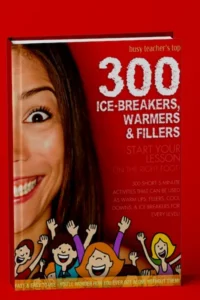Ice-Breakers 300 warmers and fillers for teachers to help students become more involved in the classroom and get in the mood for learning English.
Ice-Breakers 300 warmers and fillers
This book contains 300 warmers and fillers that will help your students become more involved in the classroom and get in the mood for learning English.
These are 300 awesome ways to start (or finish) your lesson!
Nothing can be learned if the students are tense and unwilling to speak. Start your lesson on the right foot with any of these 300 MORE short 5-minute activities that can be used as warm ups, fillers, cool downs or ice-breakers for every level!
Examples
Here are some Ice-Breakers to get all the 300 Ice-Breakers warmers and fillers get the PDF file at the end of this article.
1- NAME AS MANY…
This ‘Name As Many … as possible’ activity works very well as a warmer to start a lesson – hand out the cards to the teams or individual students and have them compete (orally if used with Intermediate or Upper Intermediate, or using a dictionary with used with lower levels).
Example cards: Name 5 body parts above the neck that have 3 letters, Name the continents in alphabetical order, Name as many languages as you can, etc.
2. SHOUT OUT
Ss shout out the words they know in English. Then they use them to make the longest sentence possible. Put them into groups and tell them to make a list of all the words they know in English. Then get the groups to write the words up on the board. In theory, the board should be covered by a mass of words. This should boost the students’ confidence and leave your board pens dry.
3. LEARNING NAMES
- Draw on the board as many objects as the letters in your name. The first letter of the name of each object must be a letter in your name. Draw the objects at random order.
- Have your students tell you the names of each object and write them on the board.
- Then, tell them that they have to put the first letter of the name of each object in the correct order so as to come up with your name.
- Finally, ask your students to do the same so that the rest of the class can guess their names.
4. SIMILARITIES
This activity requires no preparation. The students must ask each other questions until they find three things that they have in common. They must be things that are not obvious. For example, they can’t say ‘we both have black hair. It is easy to model the activity interviewing a student until you find three things that they have in common with you.
5. PAIR INTERVIEW
Ss interview their partners, then introduce their partners to the class. “This is my friend, Jim Thomson, he lives in Dundee, etc…”. Simple enough, but the variations are really fun. Have the students interview each other and explain to the class the following topics: Their day, Their favorite book and magazine and why, Their favorite food, a memorable vacation, etc…


